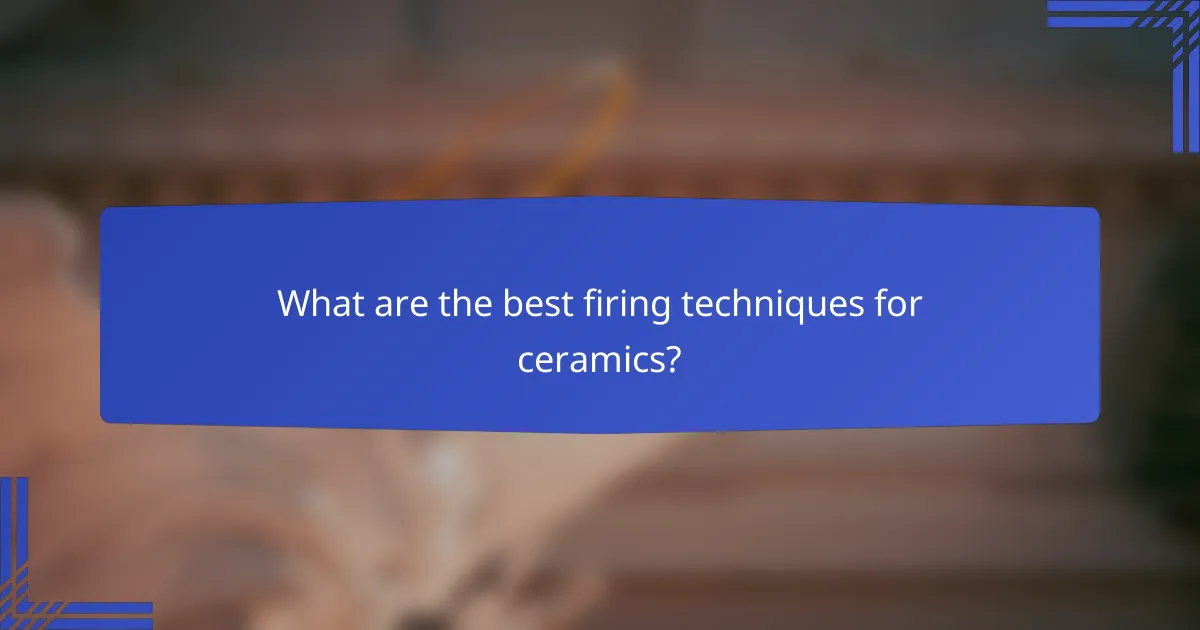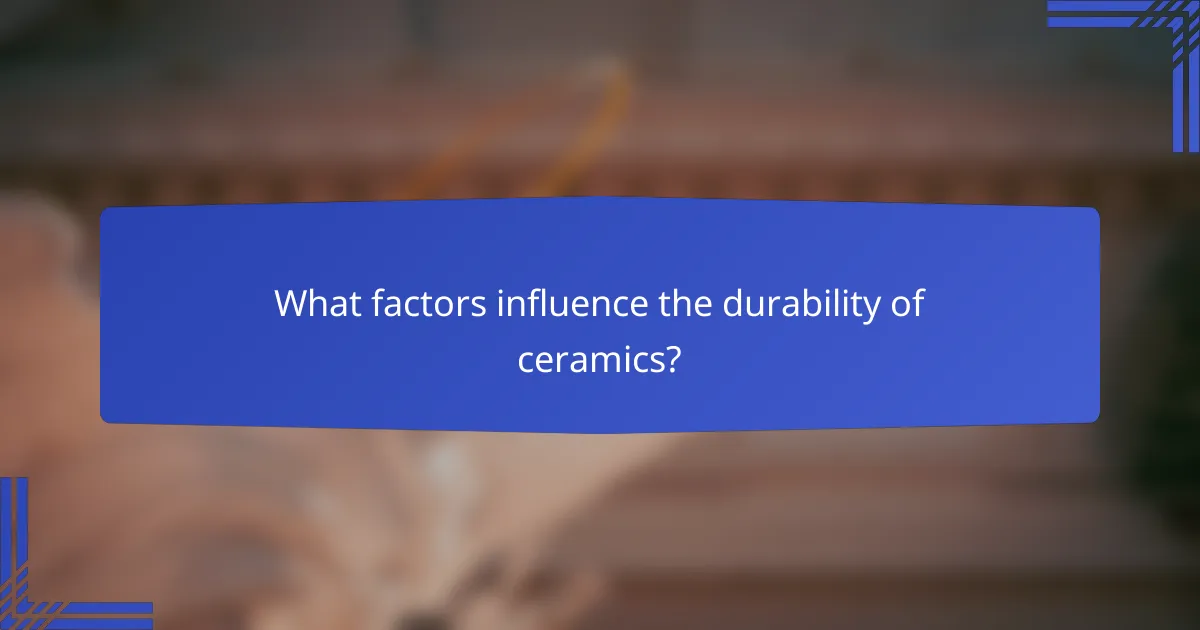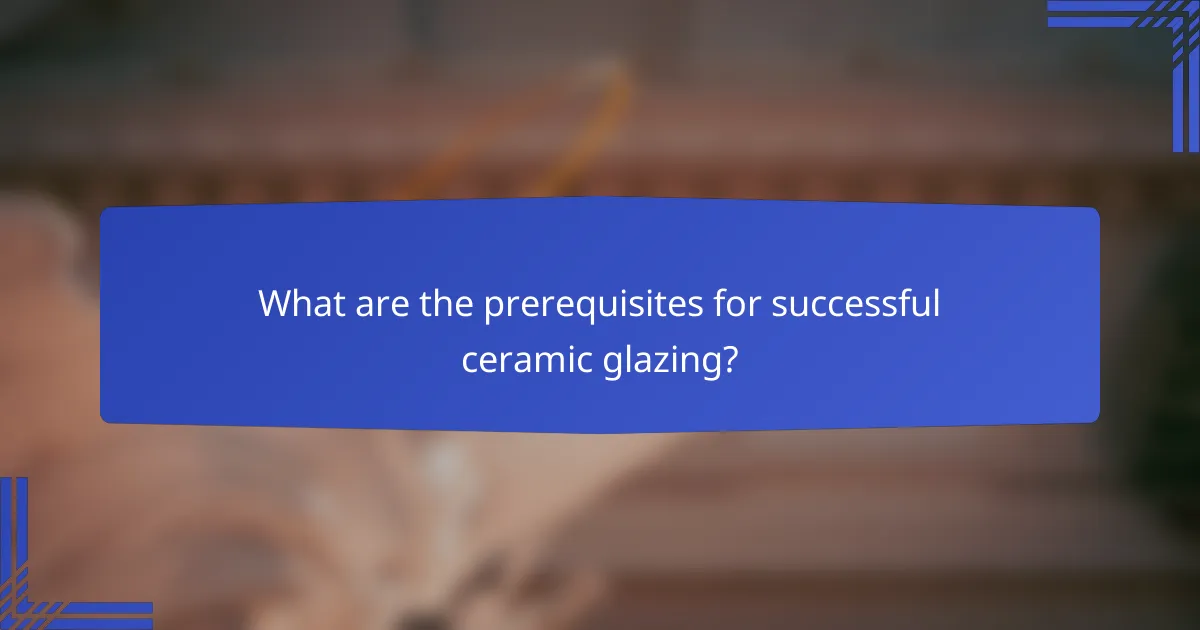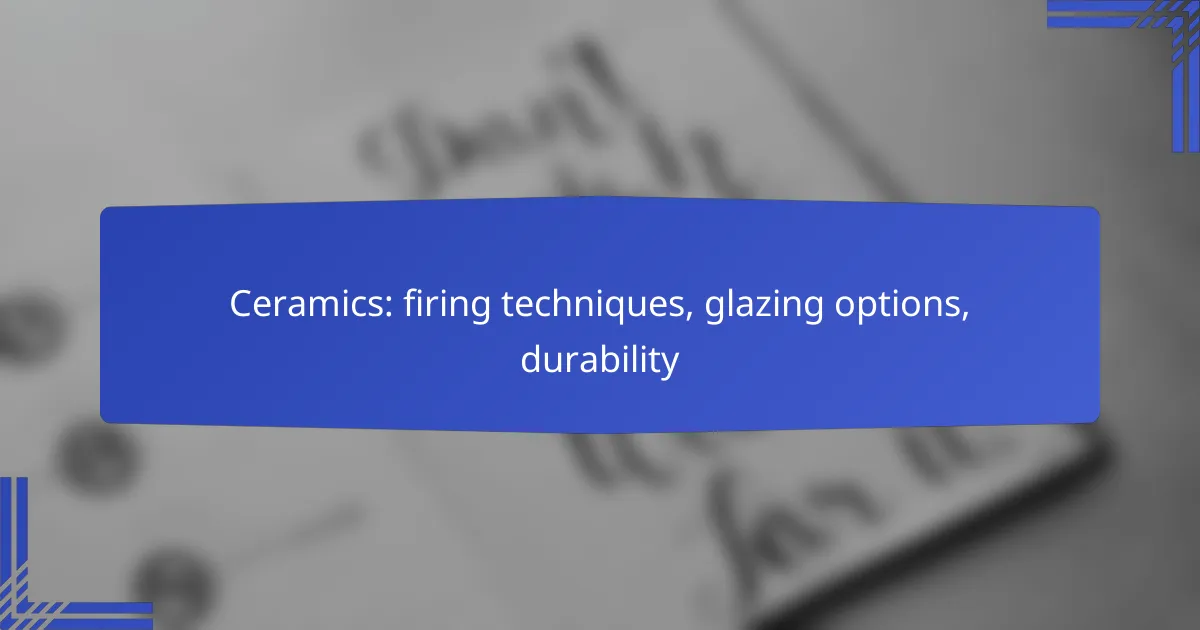Ceramics are crafted through various firing techniques that not only enhance their aesthetic appeal but also improve structural integrity. The choice of glazing options further influences the surface characteristics and durability of the final product, making it essential to consider both for optimal results. Additionally, factors such as material composition and firing temperature play a crucial role in determining the overall resilience of ceramic pieces.

What are the best firing techniques for ceramics?
The best firing techniques for ceramics include methods that enhance the final product’s aesthetic and structural integrity. Each technique has unique characteristics that influence the color, texture, and durability of the finished piece.
Oxidation firing
Oxidation firing occurs in an oxygen-rich environment, typically in electric kilns or gas kilns with sufficient air supply. This method results in bright colors and a glossy finish, making it popular for decorative ceramics.
When using oxidation firing, temperatures usually range from 1,800°F to 2,400°F (982°C to 1,316°C). It is essential to monitor the kiln atmosphere to achieve the desired effects, as variations can lead to unexpected results.
Reduction firing
Reduction firing takes place in an oxygen-restricted environment, which alters the chemical reactions during firing. This technique often produces rich, deep colors and unique surface textures, appealing to artists seeking distinctive finishes.
Commonly used in gas kilns, reduction firing temperatures are similar to oxidation, generally between 1,800°F and 2,400°F (982°C to 1,316°C). Careful control of the kiln atmosphere is crucial to avoid defects and achieve the desired aesthetic.
Sagger firing
Sagger firing involves placing ceramics in a protective container, known as a sagger, during the firing process. This technique shields the pieces from direct flame and ash, allowing for unique surface effects and finishes.
This method can be used in both oxidation and reduction atmospheres, with temperatures typically ranging from 1,800°F to 2,400°F (982°C to 1,316°C). Artists often experiment with different materials inside the sagger to create varied results.
Raku firing
Raku firing is a rapid firing technique that produces distinctive, crackled glazes and vibrant colors. The process involves removing pieces from the kiln while they are still glowing hot and placing them in combustible materials, which creates a reduction atmosphere.
Raku typically occurs at lower temperatures, around 1,800°F (982°C), and requires careful handling due to the rapid cooling and potential for thermal shock. This method is popular for decorative pieces but may not be suitable for functional ware due to its lower durability.
Electric kiln firing
Electric kiln firing is a versatile and widely used technique, allowing for precise temperature control and consistent results. This method is ideal for oxidation firing and is commonly used in both home studios and educational settings.
Electric kilns can reach temperatures of up to 2,400°F (1,316°C) and are suitable for various ceramic types. They are generally easier to operate than gas kilns, making them a good choice for beginners. However, artists should be aware of the limitations in achieving certain effects compared to reduction or Raku firing methods.

How do glazing options affect ceramics?
Glazing options significantly influence the appearance, texture, and durability of ceramics. Different types of glazes can enhance or alter the surface characteristics, affecting both aesthetic appeal and practical use.
Glossy glaze
Glossy glazes create a shiny, reflective surface that enhances colors and patterns in ceramics. They are often used for decorative pieces and tableware, as the smooth finish makes them easy to clean and maintain.
However, glossy glazes can be prone to showing fingerprints and scratches, which may require more frequent cleaning. When selecting a glossy glaze, consider the firing temperature and compatibility with the clay body to avoid defects.
Matte glaze
Matte glazes provide a non-reflective finish that can give ceramics a more subdued and earthy appearance. They are popular for functional items, as they can hide imperfections and are less likely to show wear over time.
While matte glazes can be more forgiving in terms of maintenance, they may be less durable than glossy options and can absorb stains. When using matte glazes, ensure proper application techniques to avoid uneven surfaces.
Transparent glaze
Transparent glazes allow the underlying clay body or decoration to show through, enhancing the visual depth of the piece. They are often used over underglazes or decorative slips to create vibrant effects.
When choosing a transparent glaze, consider its compatibility with the colors beneath it, as some glazes can alter the appearance of the underlying layers. Proper firing is crucial to achieve the desired clarity and finish.
Opaque glaze
Opaque glazes completely cover the clay body, providing a solid color and hiding any underlying imperfections. They are often used for pieces where a uniform appearance is desired, such as in dinnerware.
While opaque glazes can offer a wide range of colors, they may limit the visibility of decorative techniques. It is essential to test the glaze on a sample piece to ensure it achieves the intended look and durability after firing.

What factors influence the durability of ceramics?
The durability of ceramics is primarily influenced by material composition, firing temperature, glaze type, and thickness. Each of these factors plays a critical role in determining how well ceramics can withstand wear, impact, and environmental conditions.
Material composition
The material composition of ceramics includes the types of clay and additives used in the mixture. Common materials like earthenware, stoneware, and porcelain have different properties, affecting their strength and durability. For instance, stoneware typically offers higher durability compared to earthenware due to its denser composition.
When selecting materials, consider the intended use of the ceramic item. For functional pieces like dinnerware, choose materials that can withstand thermal shock and mechanical stress.
Firing temperature
Firing temperature significantly impacts the durability of ceramics. Higher firing temperatures often lead to a denser and stronger final product, as they promote better vitrification. For example, stoneware is typically fired at temperatures ranging from 1,200°C to 1,300°C, enhancing its durability.
It is crucial to follow the recommended firing temperatures for specific clay bodies to achieve optimal results. Under-firing can result in weak ceramics, while over-firing may cause warping or melting.
Glaze type
The type of glaze applied to ceramics can affect both aesthetics and durability. Glazes can be glossy, matte, or textured, and their chemical composition influences how well they bond with the clay body. For instance, high-fire glazes are generally more durable than low-fire glazes due to their ability to withstand higher temperatures.
When choosing a glaze, consider its intended use. Food-safe glazes are essential for dinnerware, while decorative pieces may allow for more variety in glaze types.
Thickness
The thickness of the ceramic piece plays a vital role in its overall strength and durability. Thicker ceramics tend to be more resistant to chipping and cracking, making them suitable for functional items. However, excessive thickness can lead to uneven firing and longer drying times.
For optimal durability, aim for a balanced thickness that meets the functional requirements without compromising the piece’s aesthetic appeal. A general guideline is to keep functional pieces around 5-10 mm thick, depending on the type of ceramic.

What are the prerequisites for successful ceramic glazing?
Successful ceramic glazing requires proper surface preparation and effective application techniques. These factors significantly influence the adhesion and appearance of the glaze, ensuring a durable and aesthetically pleasing finish.
Surface preparation
Surface preparation is critical for achieving a smooth and even glaze application. Begin by cleaning the ceramic piece to remove any dust, oils, or residues that could interfere with adhesion. A light sanding may also be beneficial to create a rough texture for better grip.
After cleaning, ensure the surface is completely dry before applying glaze. If the piece has been previously fired, check for any imperfections or cracks that may need repair. Properly prepared surfaces enhance the overall durability and visual quality of the glaze.
Application techniques
There are several effective techniques for applying glaze, each suited to different types of projects. Common methods include dipping, brushing, and spraying. Dipping provides a uniform coat but may waste glaze, while brushing allows for more control but can lead to streaks if not done carefully.
When applying glaze, aim for even coverage to avoid drips or uneven textures. Multiple thin layers are generally more effective than a single thick application, as they reduce the risk of defects during firing. Always follow the manufacturer’s recommendations for drying times between applications to ensure optimal results.

How do firing techniques impact ceramic aesthetics?
Firing techniques significantly influence the aesthetics of ceramics by affecting color, texture, and overall appearance. Different methods, such as oxidation and reduction firing, can lead to distinct visual outcomes that enhance or alter the final piece’s design.
Color variations
Firing techniques can produce a wide range of color variations in ceramics. For instance, oxidation firing typically results in brighter, more vivid colors, while reduction firing can create deeper, richer hues. The choice of clay and glaze also plays a crucial role, as certain materials react differently under various firing conditions.
When selecting colors for your ceramic pieces, consider the firing temperature and atmosphere. Low-fire glazes often yield vibrant colors, while high-fire options may produce more muted tones. Experimenting with different combinations can lead to unique and unexpected results.
Surface texture
The surface texture of ceramics is greatly influenced by the firing technique used. Techniques like raku firing can create crackled surfaces and unique patterns, while stoneware typically results in a smoother finish. The choice of glaze can further enhance or modify the texture, adding depth and interest to the piece.
To achieve specific textures, consider the application method of the glaze and the firing temperature. For example, a thicker glaze application can lead to a more pronounced texture after firing. Be mindful of how different firing techniques interact with your chosen materials to ensure the desired aesthetic outcome.

What are the emerging trends in ceramic firing and glazing?
Emerging trends in ceramic firing and glazing focus on sustainability, innovative materials, and advanced technology. Techniques such as low-temperature firing and the use of eco-friendly glazes are gaining popularity, allowing for reduced energy consumption and enhanced aesthetic qualities.
Firing Techniques
Modern firing techniques are evolving to include methods like electric kilns, which offer precise temperature control and reduced emissions compared to traditional gas kilns. Additionally, alternative firing methods, such as pit firing and raku, are being embraced for their unique finishes and environmental benefits.
When choosing a firing technique, consider the desired outcome and the materials used. For example, low-fire ceramics typically require temperatures between 1,830°F and 2,200°F (1,000°C to 1,200°C), while high-fire ceramics can reach up to 2,600°F (1,430°C). Each method impacts the final product’s durability and appearance.
Glazing Options
Glazing options are expanding with the introduction of new materials and techniques. For instance, the use of non-toxic and lead-free glazes is becoming standard, aligning with health and safety regulations. Additionally, innovative glazing methods like underglaze and overglaze techniques allow for more intricate designs and color applications.
When selecting a glaze, consider factors such as compatibility with the clay body and the firing temperature. Glazes can be glossy, matte, or textured, each offering different visual effects. Experimenting with layering glazes can also yield unique results, but it’s essential to test combinations to avoid adverse reactions during firing.
Durability Considerations
Durability in ceramics is influenced by both the firing technique and the glazing options chosen. High-fired ceramics are generally more durable and resistant to thermal shock compared to low-fired pieces. Understanding the intended use of the ceramic item can guide decisions on the appropriate firing and glazing methods.
To enhance durability, consider using stoneware or porcelain clays, which are known for their strength. Additionally, applying a clear glaze can protect the underlying surface and improve longevity. Always conduct thorough testing to ensure that the final product meets the required standards for durability and safety.
